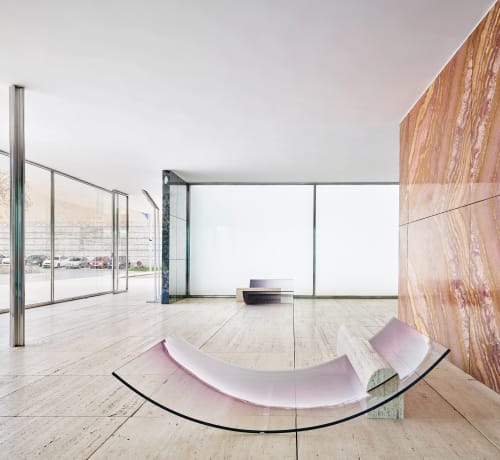The Fundació Mies van der Rohe and Side Gallery present No Fear of Glass, the site-specific intervention by Dutch designer Sabine Marcelis in the Mies van der Rohe Pavilion. The exhibition and the book that will be published later will include the contributions by the architect Ippolito Pestellini (OMA), the independent curator Maria Cristina Diderot and the architect Anna Puigjaner (MAIO).
No Fear of Glass seeks the contrast between the request made to Mies van der Rohe to “not use too much glass” in the German Pavilion of 1929, with the creative proposal of Sabine Marcelis herself, where glass is the key element, pushing the limits of the material to its end. Mies van der Rohe and Lilly Reich used the materials to test their design ideals; Marcelis uses the experimentation of materials and production to create new and surprising applications that dialogue with the materiality and shapes of the Pavilion.
_____________________________
The work of Sabine Marcelis defies fixed definitions. For years she has been working tirelessly to push the limits of materials, extending their qualities and performance. What at first glance looks like a purely aesthetic exercise is actually the output of a scientific and systematic research into production processes.
The act of design in her practice becomes a different story, one where light, color, reflection, strength and curvature are the driving categories of a research that is not limited to form and geometry, and that transcends the scale of objects as we know it. With a similar attitude she has worked on the scale of delicate domestic artefacts and on interior architecture, stretching the territory of her research beyond disciplinary boundaries.
Sabine Marcelis meets Mies Van Der Rohe in one of his most iconic and exemplary spaces.
She has looked at the Barcelona Pavilion’s materials – glass, travertine and chrome – with intelligence, to design a series of new pieces that seem to emerge from the architecture itself: two chaise longues, a fountain and two pillar lights. These are not just extrusions of existing elements; they rather act as subtle agitations, interfering gently with the cartesian order of the Pavilion. Faithful to Mies van der Rohe’s and Lilly Reich’s original approach, each of the five new objects derive their inspiration and proportions from the Pavilion itself, reconciling the scale of the architecture to the one of the object. The two chaise longues are very large as their dimensions follow the size of the travertine floor tiles, but the size of the neck-rest and the radius of the curved glass makes them suddenly functional. Extending from floor to ceiling a mirrored glass pillar light adds a ninth column to the eight already existing in the pavilion. Finally a large fountain made by a curved sheet of glass literally blends the perfectly flat and reflective water surface, adding a natural element to the selection of key components of the original design.
“No Fear of Glass” is not a just solo show, it is an hymn to the infinite liberating possibilities that modernism still has to offers and that Sabine Marcelis has unlocked vividly in front of our own eyes.
Ippolito Pestellini, partner OMA/AMO
_____________________________
The Barcelona Pavilion by Mies van der Rohe with Lilly Reich, embodies the spirit of twentieth-century Modern architecture: built by the Germans in 1929, it is at the same time a powerful masterpiece and a difficult space to confront, but certainly not for a designer of Marcelis’ temper. Her magical mix of audacity, self control and steadiness is infused with an instinctive talent: aware of the challenging task, Sabine Marcelis treated this historical jewel with white gloves, establishing a dialogue by listening to the building itself.
On the contemporary international platform, Sabine Marcelis’ approach to the world of design is unique and highly recognisable: her design is sharp, severe and at the same time syrupy, honeyed – you might even want to smell or bite her pieces of furniture, which are always extraordinary. Her work is never aggressive, but smooth and carefully thought through; her poetic is never shouted but always loudly present; her focus is on materials, mostly used in their absolute purity – marble and glass, resin, and even water. The simple but carefully studied shapes merge with the intense and extensive use of block colour, and inform the production of this clever Dutch-New Zealand designer, based in Rotterdam. Now her collection of objects enters van der Rohe’s territory. She is respectful of this act. She copes with this striking venue with modesty, tenacity, and a good amount of bravery combined with her distinctive delicacy. Nevertheless, to pay respect does not mean to remain silent: Sabine’s gesture is not invisible within this venue, but has a strong presence. A peculiar aura, successfully succeeding not to be outshone by his majesty.
Maria Cristina Didero, independant curator


